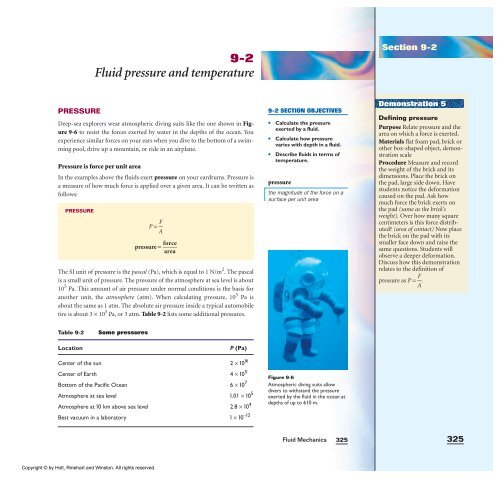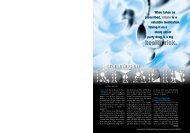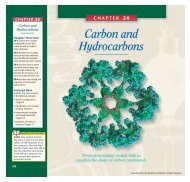Create successful ePaper yourself
Turn your PDF publications into a flip-book with our unique Google optimized e-Paper software.
PRESSURE<br />
9-2<br />
<strong>Fluid</strong> pressure and temperature<br />
Deep-sea explorers wear atmospheric diving suits like the one shown in Figure<br />
9-6 to resist the forces exerted by water in the depths of the ocean. You<br />
experience similar forces on your ears when you dive to the bottom of a swimming<br />
pool, drive up a mountain, or ride in an airplane.<br />
Pressure is force per unit area<br />
In the examples above the fluids exert pressure on your eardrums. Pressure is<br />
a measure of how much force is applied over a given area. It can be written as<br />
follows:<br />
PRESSURE<br />
F<br />
P = ⎯⎯ A<br />
pressure = ⎯ force<br />
⎯<br />
area<br />
The SI unit of pressure is the pascal (Pa), which is equal to 1 N/m 2 . The pascal<br />
is a small unit of pressure. The pressure of the atmosphere at sea level is about<br />
10 5 Pa. This amount of air pressure under normal conditions is the basis for<br />
another unit, the atmosphere (atm). When calculating pressure, 10 5 Pa is<br />
about the same as 1 atm. The absolute air pressure inside a typical automobile<br />
tire is about 3 × 10 5 Pa, or 3 atm. Table 9-2 lists some additional pressures.<br />
Table 9-2 Some pressures<br />
Location P (Pa)<br />
Center of the sun 2 × 10 16<br />
Center of Earth 4 × 10 11<br />
Bottom of the Pacific Ocean 6 × 10 7<br />
Atmosphere at sea level 1.01 × 10 5<br />
Atmosphere at 10 km above sea level 2.8 × 10 4<br />
Best vacuum in a laboratory 1 × 10 −12<br />
Copyright © by Holt, Rinehart and Winston. All rights reserved.<br />
9-2 SECTION OBJECTIVES<br />
• Calculate the pressure<br />
exerted by a fluid.<br />
• Calculate how pressure<br />
varies <strong>with</strong> depth in a fluid.<br />
• Describe fluids in terms of<br />
temperature.<br />
pressure<br />
the magnitude of the force on a<br />
surface per unit area<br />
Figure 9-6<br />
Atmospheric diving suits allow<br />
divers to <strong>with</strong>stand the pressure<br />
exerted by the fluid in the ocean at<br />
depths of up to 610 m.<br />
<strong>Fluid</strong> <strong>Mechanics</strong><br />
325<br />
Section 9-2<br />
Demonstration 5<br />
Defining pressure<br />
Purpose Relate pressure and the<br />
area on which a force is exerted.<br />
Materials flat foam pad, brick or<br />
other box-shaped object, demonstration<br />
scale<br />
Procedure Measure and record<br />
the weight of the brick and its<br />
dimensions. Place the brick on<br />
the pad, large side down. Have<br />
students notice the deformation<br />
caused on the pad. Ask how<br />
much force the brick exerts on<br />
the pad (same as the brick’s<br />
weight). Over how many square<br />
centimeters is this force distributed?<br />
(area of contact) Now place<br />
the brick on the pad <strong>with</strong> its<br />
smaller face down and raise the<br />
same questions. Students will<br />
observe a deeper deformation.<br />
Discuss how this demonstration<br />
relates to the definition of<br />
F<br />
pressure as P = ⎯⎯. A<br />
325
















